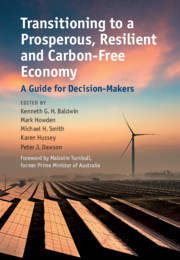Book contents
- Transitioning to a Prosperous, Resilient and Carbon-Free Economy
- Transitioning to a Prosperous, Resilient and Carbon-Free Economy
- Copyright page
- Dedication
- Contents
- Figures
- Tables
- Contributors
- Foreword
- Introduction
- 1 Policy Frameworks and Institutions for Decarbonisation: The Energy Sector as ‘Litmus Test’
- Technologies for Decarbonising the Electricity Sector
- 2 Wind Energy
- 3 Solar Photovoltaics
- 4 Solar Thermal Energy
- 5 Nuclear Energy
- 6 Hydropower
- 7 Energy Storage
- 8 The Hydrogen Economy
- Example Economies
- Cities and Industry
- Land Use, Forests and Agriculture
- Mining, Metals, Oil and Gas
- Addressing Barriers io Change
- Index
- References
4 - Solar Thermal Energy
from Technologies for Decarbonising the Electricity Sector
Published online by Cambridge University Press: 08 October 2021
- Transitioning to a Prosperous, Resilient and Carbon-Free Economy
- Transitioning to a Prosperous, Resilient and Carbon-Free Economy
- Copyright page
- Dedication
- Contents
- Figures
- Tables
- Contributors
- Foreword
- Introduction
- 1 Policy Frameworks and Institutions for Decarbonisation: The Energy Sector as ‘Litmus Test’
- Technologies for Decarbonising the Electricity Sector
- 2 Wind Energy
- 3 Solar Photovoltaics
- 4 Solar Thermal Energy
- 5 Nuclear Energy
- 6 Hydropower
- 7 Energy Storage
- 8 The Hydrogen Economy
- Example Economies
- Cities and Industry
- Land Use, Forests and Agriculture
- Mining, Metals, Oil and Gas
- Addressing Barriers io Change
- Index
- References
Summary
Solar thermal technology provides a wide range of opportunities for climate-resilient global development. High-temperature concentrating solar thermal power (CSP) systems are used to generate flexible, dispatchable renewable electricity in large-scale grid-connected systems and could also soon be used as a heat source for industrial processes such as for desalinated water, fuels, chemical products and refined ores. Most CSP electricity systems include thermal energy storage units, allowing output to continue for hours after sunset. Solar thermal systems, which rely on heating up a working medium to operate, are distinct from solar photovoltaic (PV) technologies that directly convert solar photons into electric current. In addition to CSP, low-temperature solar thermal systems, used for domestic hot water and other applications, are briefly reviewed.
- Type
- Chapter
- Information
- Transitioning to a Prosperous, Resilient and Carbon-Free EconomyA Guide for Decision-Makers, pp. 72 - 104Publisher: Cambridge University PressPrint publication year: 2021
References
- 1
- Cited by

